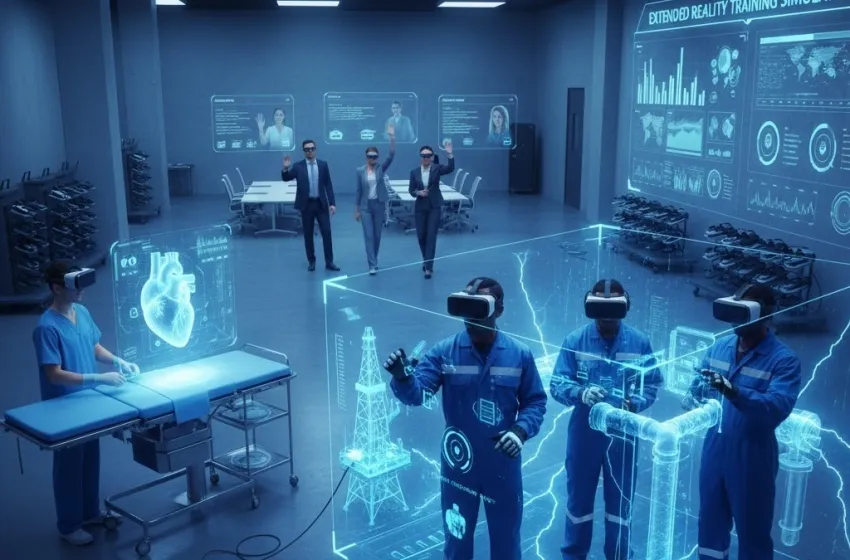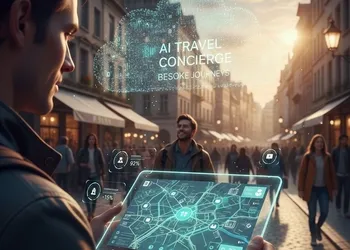Transform corporate training with Extended Reality (XR)
The landscape of corporate training is undergoing a profound transformation, moving away from static presentations and manuals toward dynamic, hands-on, and deeply engaging experiences. At the heart of this revolution is Extended Reality (XR), an umbrella term that encompasses Virtual Reality (VR), Augmented Reality (AR), and Mixed Reality (MR). XR technologies are redefining how businesses onboard new hires, upskill veteran employees, and manage complex, high-risk operational procedures. By merging the physical and digital worlds, XR unlocks a new paradigm of immersive learning that promises unprecedented levels of engagement, knowledge retention, and practical skill transfer.
What is Extended Reality (XR)?
Extended Reality (XR) is a spectrum of technologies designed to blend the real and virtual worlds. Each component offers a unique level of immersion:
Virtual Reality (VR)
This is a fully synthetic digital environment. Users wear a headset that completely shuts out the real world, immersing them in a 360-degree, three-dimensional simulation. It’s ideal for simulating scenarios that are too dangerous, costly, or rare to reproduce physically.
Augmented Reality (AR)
AR overlays digital information (like graphics, text, or 3D models) onto the user's real-world view, typically through a smartphone, tablet, or smart glasses. It enhances the real environment, providing contextual, on-the-job assistance.
Mixed Reality (MR)
MR takes AR a step further by allowing digital and real-world objects to interact with each other in real-time. This provides the deepest blending of the two realities, often requiring specialized MR headsets.
In the context of enterprise learning, these modalities are collectively referred to as XR, and their application in corporate training is proving to be a game-changer.
AR/VR Simulation for High-Risk Industrial Training
One of the most impactful applications of XR is in the realm of high-risk and technical occupations, where the cost of error is immense, potentially involving injury, equipment damage, or environmental disaster. For industries like oil and gas, aviation, manufacturing, mining, and healthcare, using AR/VR simulation creates highly realistic, safe, and engaging training environments.
The Need for Realistic, Safe Training
Traditional training methods for complex machinery or hazardous procedures—such as on-the-job shadowing or classroom instruction—are often inadequate. They either expose trainees to unacceptable risks or fail to provide the muscle memory and decision-making experience necessary for a high-stress scenario.
Using AR and VR technologies to create highly realistic, safe, and engaging training simulations for high-risk industrial or technical jobs directly addresses these challenges:
- Safety and Risk Mitigation: In a VR simulation, an employee can practice emergency shutdowns in a nuclear power plant, repair a faulty oil rig component, or perform a fire-fighting exercise without any real-world danger. Mistakes become learning opportunities rather than catastrophic failures. This immersive learning environment removes the paralyzing fear of failure, allowing for repeated practice until mastery is achieved.
- Unprecedented Realism and Fidelity: Modern VR platforms can create digital twins of complex industrial equipment and environments with stunning accuracy. Trainees interact with virtual controls, gauges, and physics-based systems that behave exactly as their real-world counterparts. This high fidelity ensures that the skills learned in the simulation are directly transferable to the job.
- Cost and Logistics Efficiency: Simulating an entire factory floor or a deep-sea drilling operation in the real world is prohibitively expensive and logistically complex. AR/VR simulation eliminates the need to take operational equipment offline, purchase expensive training-only equipment, or incur significant travel and accommodation costs for remote training sites.
- Scenario Variety and Customization: Trainers can easily manipulate variables—such as equipment failure, extreme weather conditions, or hazardous material spills—to test an employee’s response to a virtually infinite number of scenarios that would be impossible or impractical to set up physically.
In fields like surgery, VR allows medical students to perform intricate procedures on a digital patient, rehearsing rare complications without risking a human life. In aviation, sophisticated flight simulators have been the gold standard for decades, but modern VR/AR headsets are making maintenance and cabin crew training more accessible and cost-effective.
Enhancing Employee Onboarding and Skill Transfer
Extended Reality (XR) is not limited to high-risk roles; it's a powerful accelerator for standard employee onboarding and general skill transfer across all enterprise functions.
Accelerated Employee Onboarding
The first few weeks are crucial for new hires. Traditional onboarding can be overwhelming, involving lengthy policy readings and generic video presentations. XR transforms this process into an active, engaging experience:
- Virtual Office Tours: New hires can explore a company's global offices in a VR environment, meeting virtual colleagues and getting a sense of the corporate culture regardless of their physical location.
- Contextual Policy Training: Instead of reading a 100-page safety manual, an employee in a manufacturing facility can wear AR glasses that overlay safety warnings and procedural steps directly onto the machinery they are inspecting. This just-in-time, contextualized information improves comprehension and adherence.
- Soft Skills Development: VR simulations are increasingly used for developing soft skills like conflict resolution, sales negotiations, and inclusive leadership. Trainees interact with AI-driven virtual avatars, practicing difficult conversations and receiving immediate, objective feedback on their communication style.
Maximizing Skill Transfer
The fundamental goal of any corporate training program is effective skill transfer—ensuring what is learned in the classroom or simulation is successfully applied on the job. XR excels at this:
| XR Technology | Role in Skill Transfer | Example |
|---|---|---|
| Virtual Reality (VR) | Builds muscle memory and spatial awareness for complex tasks. | A technician repeatedly practices the steps to disassemble and reassemble a jet engine in VR, building the required motor skills. |
| Augmented Reality (AR) | Provides just-in-time guidance and reduces cognitive load during execution. | A field service engineer wears AR glasses that project step-by-step instructions and technical schematics directly onto the equipment they are repairing. |
This "learning by doing" approach is scientifically proven to increase retention. Studies have shown that knowledge retention rates from XR-based immersive learning can be significantly higher than those from traditional lecture or video-based methods. Employees not only remember the information but also know how to apply it in a real-world context.
The Business Case for Immersive Learning
Beyond safety and effectiveness, the adoption of XR for corporate training delivers compelling business benefits:
- Increased Efficiency and Speed: VR training can often be completed in a fraction of the time required for traditional classroom or on-the-job training. Walmart, for instance, used VR to reduce training time for some tasks from eight hours to just fifteen minutes.
- Data-Driven Insights: XR platforms track every action a trainee takes—from response time to the number of errors and the path taken to solve a problem. This rich data provides trainers with an objective measure of competency, allowing for personalized remediation and clear identification of knowledge gaps.
- Scalability and Consistency: A single, high-quality AR/VR simulation can be deployed instantly to thousands of employees across the globe, ensuring that everyone receives a standardized, high-quality, and consistent training experience, regardless of their location or the availability of an expert instructor.
- Engagement and Motivation: The novel, interactive nature of immersive learning naturally boosts trainee engagement. When learning is fun, challenging, and relevant, employees are more motivated to participate and more invested in their own professional development.
These reflect the user's commercial or informational intent when searching, covering the Why, What, and How of XR adoption:
- Informational Intent: Benefits of XR for training, How VR improves knowledge retention, What is extended reality in business
- Commercial Intent: Best AR/VR training platforms, XR training implementation guide, Cost of VR corporate training, AR training providers
- Transactional Intent: Buy corporate VR training solution, Extended reality training for employees
By strategically integrating these semantic and intent keywords, the content is optimized to rank for a wide array of relevant user queries, positioning it as a definitive resource on Extended Reality (XR) in Enterprise Training. As technology continues to advance, the blend of physical and digital training offered by immersive learning will solidify its position as the standard for effective, scalable, and safe corporate training for a future-ready workforce, making employee onboarding and skill transfer more effective than ever before.




























